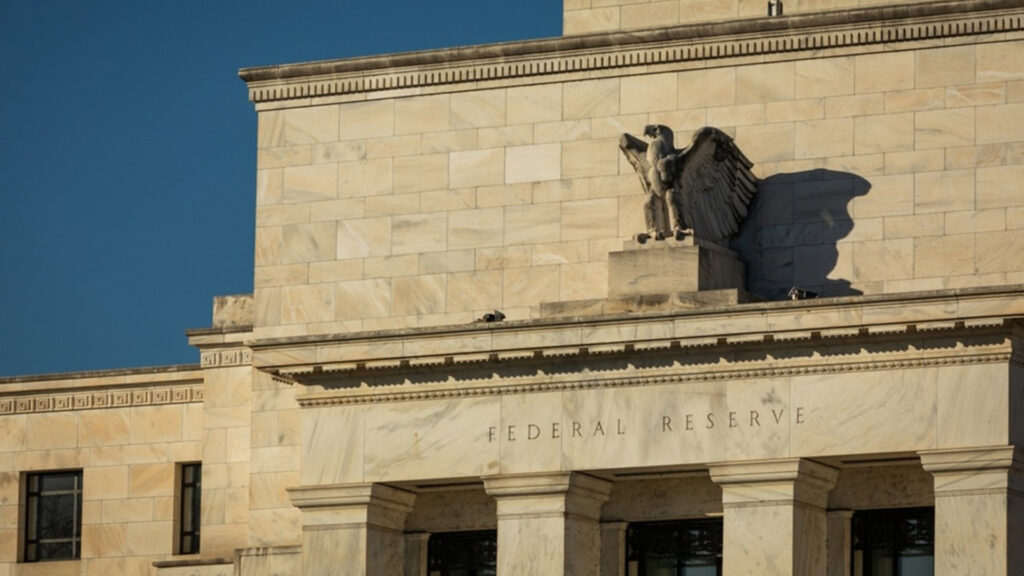Fed Chairman Jerome Powell stated that the central bank might cut rates at its upcoming meeting on September 17th due to rising risks to the labor market while acknowledging inflation risks.
While giving his speech at the Jackson Hole symposium, Powell continued his approach cautiously to monetary policy changes.
Powell Signals Possible Rate Cut
Chairman Powell stated that the Fed might be on track to cut rates in September, which would mark the first cut since last year when the Fed reduced rates by 50 basis points in September 2024.
He pointed to a shifting balance of risks in the US economy, especially after recent weakness in the labor market data. Financial markets reacted quickly, increasing speculation of a 25-basis point rate cut in September, with forecasts of a total reduction of 50 basis points in late 2025. ⁽¹⁾
However, the decision was not finalized, with inflation remaining a concern for the Fed. Powell noted that US President Trump’s tariffs could continue to increase prices, creating more inflationary pressures. The upcoming labor market data and inflation data could heavily impact the Fed’s decision.
Labor Market Concerns Remain in the Spotlight
The labor market has moved front and center for the Federal Reserve, highlighting its fragility and risk to the economy. highlighting risks to the economy. Unemployment remains at 4.2%
This precarious situation means even a relatively small increase in layoffs could lead the economy to start shedding jobs, a process that can be difficult to reverse once it starts. ⁽²⁾
The Fed has become increasingly focused on this potential risk, especially after revisions included in the July employment report showed much weaker job growth in recent months than previously thought. This is why, while inflation is above the Fed’s 2% target, Fed Chair Jerome Powell on Friday signaled the central bank’s policymakers could cut rates when they meet next month. ⁽³⁾
New Monetary Policy Framework
Powell also announced changes to the Fed’s monetary policy framework, concluding a review that began in late 2024. The Fed has scrapped its older strategy, which allowed inflation to rise above its 2% target after periods of low inflation. This shift indicated different challenges faced in recent years compared to pre-2020 periods. ⁽⁴⁾
Fed officials also edited the document’s instructions about how to approach the low-unemployment goal. Under the 2020 framework, the Fed described its goal as avoiding “shortfalls” in unemployment. That term has now been removed from the strategy document. ⁽⁵⁾
Powell said Friday that the Fed’s focus on shortfalls was often misinterpreted by investors and economists, who thought it meant that the Fed would never proactively move to cool down an overheating labor market.
The new strategy document has more balanced language, which refers more generally to the Fed’s aim of promoting “maximum employment.”
Political Pressure
The weekend was overshadowed by attacks from the White House on Fed Governor Lisa Cook, who at one point was confronted in the lobby of the Jackson Lake Lodge by Trump ally James Fishback, before he was removed by security personnel. ⁽⁶⁾
On Friday, the president said he would fire Cook if she doesn’t resign from her post over allegations that she engaged in mortgage fraud. That followed a statement from Cook on Wednesday in which she said she would not be bullied into stepping down.
The attacks on Cook from the White House has added pressure to the Fed this year to cut rates. It raises the stakes for the Fed as Trump weighs who to choose as Powell’s replacement when the chair’s term ends in May.
Global Central Bank Views
During a Saturday panel that featured three major central bank chiefs, leaders of the Bank of Japan and the Bank of England steered clear of comments on the outlook for monetary policy, but spoke to the difficult challenges of expanding their countries’ labor forces.
In Japan, where an aging population and low birth rate are squeezing the labor market and pushing up inflation, BOJ Governor Kazuo Ueda said bringing more women into full-time jobs and employing more foreign workers could help address the problem. ⁽⁷⁾
BOE Governor Andrew Bailey highlighted the struggle of weak productivity and a poor labor-force participation rate. ⁽⁸⁾
European Central Bank President Christine Lagarde had a more upbeat message, saying Europe’s labor market has proved surprisingly resilient in the face of a once-in-a-generation inflation shock and aggressive interest-rate hikes. She also said that inflation has fallen sharply. ⁽⁹⁾



